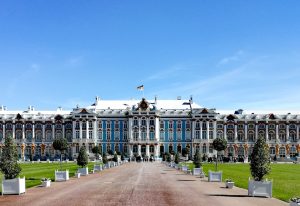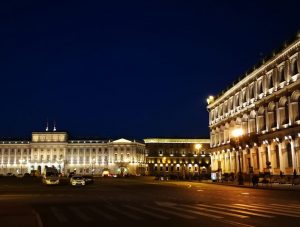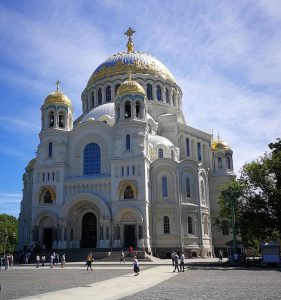
Fountains at Peterhof Palace
This May, St Petersburg celebrated 315 years since its foundation. St Petersburg is one of the few cities in the world to have experienced a large number of historically important political and economic events over a relatively short period of time. The reign of eleven emperors, the Bolshevik Revolution, the cruel three-year siege during the war, dozens of floods, economic and political collapse, impressive economic reform and the subsequent complex path to modernisation.
Saint Petersburg as we know it today was founded by Tsar Peter the Great. A desire to change views on a nation which until then had been seen as backwards and stuck in the Middle Ages led the Tsar to make major changes in Russians’ general style of life, in accordance with the model of the then advanced Europe. These changes affected everything, from city redevelopments, a new architecture style, economic changes, administrative changes and changes in the way of dressing and behaviour of the population, with the introduction of social rules, cultural events and new traditions.
St Petersburg’s history began essentially with a war that broke out between Sweden and Russia over access to trade routes to Europe across the Baltic Sea. Peter the Great ordered the construction of the Peter and Paul Fortress located in the centre of the city, which had a major impact on its defence and future strategic development. The first stone was laid on 27 May 1703.

Museum Fabergé

Russian barock

Saint Isaac ́s Cathedral
Renowned architects such as Domenica Trezzini, Jean-Baptiste Leblond, Bartolomeo Rastrelli and many others were invited to St Petersburg. Tens of thousands of Russians from across different regions were forced to help construct the city in line with European standards. Peter the Great wanted to build a second Venice, and he also found inspiration in Paris and Amsterdam. A new city was built up on the site of a swamp, a city with the most extensive red granite paving in the world, a city interwoven with water channels and dozens of bridges. The special architecture known as Russian Baroque was born.
It was mainly Empresses Catherine II (1762-1796) and Elizabeth who were responsible for the city’s further development and rich history. Over this 50-year golden age of Russian art, Russian Baroque, then Classical style were implemented in architectural works such as the Winter Palace, Smolny Convent, St Vladimir’s Cathedral , Anichkov Palace, the Marble Palace, the Old Hermitage, the Admiralty Building, the Stock Exchange, etc., mainly built along both embankments of the Neva River. The golden age continued with the reign of Alexander I, who fought Napoleon, Nicholas I, Nicholas II, and Alexander II and III.
The city’s population grew tenfold over a short period. As such, slums began to appear, high-density buildings with dark and damp courtyards in which Dostoevsky set his novel (Crime and Punishment). The fast growing city was beginning to contend with the consequences of the arrival of the First World War, with social problems and with a growing chasm between the upper feudal class and the working class “muzhiks”. In the end, Russia’s war with Japan, a depression and reckless reforms led to an armed rebellion across the empire led by the Bolsheviks and the end of Russian autocracy.
Economic decay after the First World War, a depopulated countryside, and a dissatisfied and hungry nation represented a simple and understandable tactical tool for Lenin, who quickly and brutally turned
on the head of the whole of Russia’s despotic feudal system, putting an end to the Emperor and setting up the Soviet era. It is remarkable that the new illiberal Soviet regime, despite bringing no improvement in the nation’s situation, survived a whole 70 years, although Lenin’s era did not last that long. Lenin’s idealistic economic strategy was unable to overcome economic decay and impose law and order on the growing anarchy. Every attempt at restoring the monarchy was brutally suppressed, and the Soviet dictatorship of the proletariat was implemented under the oppression and brutal rule of Stalin and his empire. Even during this period, however, Prokofiev and Shostakovich, for example, lived and worked on their craft here.
Beginning in the mid-1980s, the catastrophic consequences of Russia’s incompetent economic policy and social oppression forced the Communist Party to implement new reforms and make fundamental changes within the archaic Communist Party Central Committee leading to Mikhail Gorbachev’s policies of perestroika and glasnost. Further inflation and uncontrolled new reforms leading to an attempt at opening the country to the free market in 1990 found the country instead heading towards economic collapse and the end of the Soviet Union.

Catherin ́s Palace

Senate square

Kronstadt Naval Cathedral
In 1991, the city of Leningrad was once again renamed Saint Petersburg, and over time it prevailed over political idealism, finally leading to growth in enterprise and capital development.
Many international cultural institutions, heads of state and major societies took part in this year’s celebrations of the city’s 315th anniversary, including France’s Fraternity of Knights of the Wine- Tasting Cup (Chevaliers de tastevin). One hopes that this new era of prosperity, efforts at establishing democracy and open international relations will become a permanent feature of St Petersburg’s future.
Author: Ing. Arch. Iva Drebitko;
Photos: author’s archives

